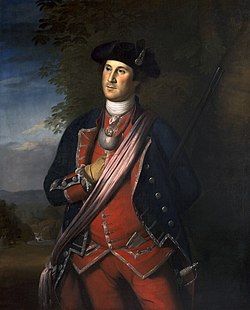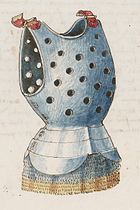Gorget
This article needs additional citations for verification. (December 2012) |


A gorget /ˈɡɔːrdʒ[invalid input: 'ɨ']t/, from the French gorge meaning throat, was originally a band of linen wrapped around a woman's neck and head in the medieval period,[2][3] or the lower part of a simple chaperon hood. The term subsequently described a steel or leather collar designed to protect the throat, a set of pieces of plate armour, or a single piece of plate armour hanging from the neck and covering the throat and chest. Later, particularly from the 18th century onwards, the gorget became primarily ornamental, serving only as a symbolic accessory on military uniforms, a use which has survived to the modern day in some armies.
The term may also be used of other things such as items of jewellery worn around the throat region in a number of other cultures, for example wide thin gold collars found in Ireland dating to the Bronze Age.[4]
As part of armour

In the High Middle Ages, when mail was the primary form of metal body armor used in Western Europe, the Mail coif protected the neck and lower face. During the 14th century as more plate armor appeared to supplement mail, the Bascinet helmet incorporated a mail curtain called the Aventail which protected the lower face, neck and shoulders. A separate mail collar called a "pisan" or "standard" was sometimes worn under the aventail as additional protection.[5] Towards the end of the 14th century, threats including the increased penetrating power of the lance when paired with a lance rest on the breastplate made more rigid forms of neck protection desirable.[6] One solution was a standing collar plate worn over the aventail and separate from the helmet, which was wide enough for the helmet to move around in so that the man-at-arms could turn his head. Through the early 15th century, gorget plates were integrated into the helmet itself to form the great bascinet. Other forms of helmet such as the sallet which did not protect the lower face and throat with plate were paired with a separate bevor, and the armet was often fitted with a wrapper that included gorget lames protecting the throat. During this time, the mail standard was still used.
At the beginning of the 16th century, the gorget became fully developed as a component of plate armor in its own right. Unlike previous gorget plates and bevors which sat over the breastplate and required a separate mail collar to fully protect the neck from gaps, the developed gorget was worn under the back and breastplate and was intended to cover a larger area of the neck, nape, shoulders, and upper chest, since the upper edges of the cuirass had become lower than before. The gorget served as an anchor point for the Pauldrons, which either had holes to slide over pins projecting from the gorget, or fastened to the gorget by straps and buckles. The neck was protected by a high collar of articulated lames, and the overall gorget consisted of front and back pieces which were hinged at the side so it could be put on and taken off. Some helmets had additional neck lames which overlapped the gorget, while others fitted tightly to the top of the gorget so that there would be no gap between them.
By the 17th century there appeared a form of gorget with a low, unarticulated collar and larger front and back plates which covered more of the upper chest and back. These were not worn with a breastplate as part of a full harness, but instead were worn over civilian clothing or a Buff coat. Some gorgets of this period were "parade" pieces that were beautifully etched, gilded, engraved, chased, embossed, or enamelled at great expense. Gradually the gorget became smaller and more symbolic, and became a single crescent shape worn on a chain, which suspended the gorget ever lower on the chest so that the gorget no longer protected the throat in normal wear.
The Japanese (samurai) form of the gorget, called a nodowa, was either fastened by itself around the neck, or an integral part of the face defense or men yoroi. It consisted of several lames made of lacquered leather or iron, each of which either consisted of one piece or of scales laced together in horizontal rows. The lames were articulated vertically, overlapping bottom to top, by another set of silk laces.
As part of military uniforms
As early as 1688, regulations provided for the wearing of gorgets by Swedish army officers. For those of captain's rank the gorget was gilt with the king's monogram under a crown in blue enamel, while more junior officers wore silver-plated gorgets with the initials in gold.[7]
During the 18th and early 19th centuries, crescent-shaped gorgets of silver or silver gilt were worn by officers in most European armies, both as a badge of rank and an indication that they were on duty. These last survivals of armour were much smaller (usually about three to four inches in width) than their Medieval predecessors and were suspended by chains or ribbons. In the British service they carried the Royal coat of arms until 1796 and thereafter the Royal cypher.

Gorgets ceased to be worn by British army officers in 1830, and by their French counterparts 20 years later. They were still worn to a limited extent in the Imperial German Army until 1914, as a special distinction by officers of the Prussian Gardes du Corps and the 2nd Cuirassiers "Queen". Officers of the Spanish infantry continued to wear gorgets with the cypher of King Alfonso XIII in full dress until the overthrow of the Monarchy in 1931. Mexican Federal army officers also wore the gorget with the badge of their branch as part of their parade uniform. This practice ended in 1947.
The gorget was revived as a uniform accessory during Germany's Third Reich, seeing widespread use within the German military and Nazi party organizations. During World War II, it continued to be used by German military field police, which wore metal gorgets as emblems of authority. German police gorgets of this period typically were flat metal crescents with ornamental designs that were suspended by a chain worn around the neck. Following the German example, the Finnish Defence Forces still use a metal gorget as a distinguishing mark of the duty conscript of a company; the main task is guard duty at the entrance and security within the barracks. The highly Prussianised Chilean army still use the German style metal gorget in parades and in the uniform of their own Military Police.
Gorgets in Sweden
The gorget was discontinued as a rank insignia for Swedish officers in the Swedish Armed Forces as of 1792, when epaulettes were introduced. However, use of the gorget was revived in 1799, when the Officer of the day was given the privilege of wearing a gorget which featured the Swedish lesser coat of arms. It has since been a part of the officer's uniform (when he or she functions as "Officer of the day"), a custom which continues to this day. The same use of the gorget also continues in Norway, worn by officers / corporals responsible for guard changes, and "Inspecting Officers" (officer of the day).
Indigenous peoples
The British Empire awarded gorgets to chiefs of American Indian tribes as both an honour and a badge of their high status.[8] Those being awarded a gorget were known as gorget captains [9] Gorgets were also awarded to African chiefs[10]
In colonial Australia gorgets were given to Aboriginal people by government officials and pastoralists as insignia of high rank or reward for services to the settler community. Frequently inscribed with the word "King" along with the name of the tribal group to which the recipient belonged (despite the absence of this kind of rank among indigenous Australians), the "breastplates", as they came to be known, were highly regarded by those who received one.[11]
Gorget patches

The scarlet patches still worn on each side of the collar of the tunics of British Army general officers and senior officers are called "gorget patches" in reference to this article of armour. There were two types - the first, red with a crimson centre stripe, were for Colonels and Brigadiers, and red with a gold centre stripe for General Officers. Today, they signify an officer of the General Staff, to which all British officers are appointed on reaching the rank of Colonel; the historic colour differentials are no longer worn. Air officers in the Indian and Sri Lankan air forces also wear gorget patches with one to five stars depending on their seniority.[12]
RAF officer cadets wear white gorget patches on their service dress and mess dress uniforms. Very similar collar patches are worn by British army officer cadets at Sandhurst on the standup collars of their dark-blue "Number One" dress uniforms. These features of modern uniforms are a residual survival from the earlier practice of suspending the actual gorgets from ribbons attached to buttons on both collars of the uniform. Such buttons were often mounted on a patch of coloured cloth or gold embroidery.
The functional gorget today

Recent advances in protective armour have led to the gorget being reintroduced into the US Army and Marine Improved Outer Tactical Vest and Modular Tactical Vest systems respectively.
Other uses
The state flag of South Carolina features a crescent in the upper right quadrant which now resembles a crescent moon, but which some historians have suggested may have once represented a gorget. The state flag derives from a flag designed by Colonel William Moultrie in 1775 with a blue ground and crescent based on the uniforms of the Second South Carolina Regiment, who wore a crescent with the tips pointing up on their hats. Through the 19th century, the crescent on the state flag also appeared with the tips pointing up, and it was not until the 20th century that it was turned on its side to resemble a crescent moon. The mystery of its original meaning is still unresolved, and the crescent as it appears on the modern state flag is normally interpreted as a moon.[13]
The term also refers to a broad patch of metallic-looking iridescent feathers on the throats of many male hummingbirds.
See also
References
- ^ Lossing, Benson John (1859). Mount Vernon and its associations: historical, biographical, and pictorial. W.A. Townsend and Company. p. 345.
{{cite book}}:|access-date=requires|url=(help) - ^ Norris, Herbert (1999). Medieval costume and fashion. Mineola, N.Y.: Dover Publications. p. 181. ISBN 9780486404868.
- ^ Lewandowski, Elizabeth J. The complete costume dictionary. Lanham, Md.: Scarecrow Press, Inc. p. 123. ISBN 9780810877856.
- ^ Dermot F. Gleeson, "Discovery of Gold Gorget at Burren, Co. Clare", The Journal of the Royal Society of Antiquaries of Ireland, Seventh Series, Vol. 4, No. 1 (Jun. 30, 1934), pp. 138-139, JSTOR, with photo.
- ^ https://www.youtube.com/watch?v=MrFwI4eFhf0
- ^ https://www.youtube.com/watch?v=cuGoj9jA8_0
- ^ Preben Kannik, Alverdens Uniformer I Farver", p.151
- ^ p.9 Handbook of North American Indians: History of Indian-White Relations Government Printing Office, 1978
- ^ p. 286 Blegen, Theodore Christian & Heilbron, Bertha Lion Minnesota History Minnesota Historical Society, 1928
- ^ p.41 History of the Civilization and Christianization of South Africa; from its first settlement by the Dutch to the final surrender of it to the British Waugh & Innes, 1832
- ^ National Museum of Australia: Aboriginal Breastplates
- ^ http://www.bharat-rakshak.com/IAF/Heraldry/Uniform/380-Collar-Tabs.html
- ^ Hicks, Brian (July 11, 2007). "What the heck is that doodad on our state flag?". The Post and Courier. Charleston, South Carolina.

